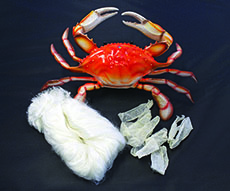With antibacterial and wound-healing properties, chitosan, a substance extracted from crustacean shells, is considered an ideal material for functional clothing. However, chitosan fibre is expensive, fragile and easy to generate static electricity during the spinning process. To tackle these problems, Dr Li Li at the Institute of Textiles and Clothing led a research team to develop a novel spinning system.
The research team span the chitosan fibres into yarn before it was woven or knitted into fabric. When spinning chitosan fibres, the friction between the fibres and the spinning roller would generate static electricity, causing the fibres to break and cling around the roller. To solve this problem, researchers specially developed a conductive spinning rollers to conduct away the static electricity generated on the fibres. Chances of breaking and clinging of yarns are therefore reduced. As a result, wastage is reduced and production cost is lowered.
Test results showed that, for sanitary and sports textiles, the more chitosan the yarns contain, the higher their ability to suppress microbial growth. When applied in wound dressings and bandages, the more chitosan the yarns contain, the faster a wound heals. When used in healthcare products, the softness and comfort of the chitosan fibres are particularly crucial for those users with sensitive skin. The test also proved that blending chitosan with cotton gives good wearing comfort. In conclusion, this system can realise lower production cost with better product performance.
This innovation won a gold medal at the 44th International Exhibition of Inventions of Geneva.

